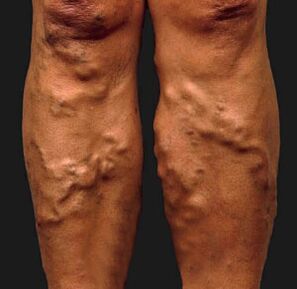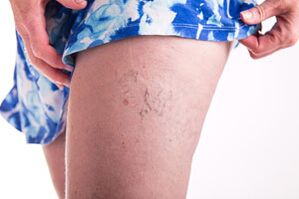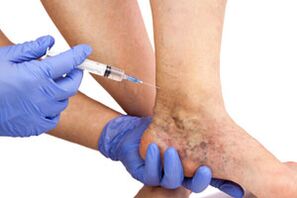
In the event of a venous blood disorder, the pressure in the veins increases, they begin to expand and become visible under the skin.Varicose diseases more often affect the veins of the lower limbs, but can occur in any organ of the human body.
Common characteristic
Varicose of the feet can affect men and women of any age, but is more common in middle -aged patients and elderly people.Varicose veins are a very common disease.Up to 15% of elderly men and almost all elderly women suffer from this disease.
Risk factors for the development of pathology:
- the presence of illness in close relatives;
- A sedentary lifestyle;
- overweight;
- long stay in the constant position;
- Pregnancy.
The causes of varicose veins
The causes of varicose veins are not fully examined.In some cases, poor blood flow through the veins is caused by the absence or weakness of the valve apparatus of the blood vessels located in the depths of the tissues.Also, varicose veins of the lower limbs and other organs can be caused by the weakness of the vascular wall itself.
The more common, varicose veins of the legs are related to the following conditions:
- transferred inflammation of the veins (phlebitis);
- the formation of blood clots in the venous line;
- Congenital abnormalities in the development of blood vessels.
The disease is characterized by a progressive course and cannot be completely cured.However, there is a very effective prevention of varicose veins - the use of compression socks, maintaining normal weight and regular physical activity, mainly walking or swimming.The dynamic load of the legs helps the muscles push the blood up the veins and not flow in the opposite direction.
Varicose

Depending on the location of pathologically altered vessels, such forms of varicose veins differ:
- Different pelvic veins in women;
- Lesion of the veins of the lower limbs;
- the enlargement of the esophageal veins during liver pathology;
- Post -clombophlebitis options in different organs.
There are such stages of varicose veins:
- Compensated: no complaints, varicose veins of the legs are visible;
- Subcompensated: patients complain of swelling, rupture, weight in the legs, convulsions at night;
- Decompensation: Skin changes develop - hyperpigmentation, signs of chronic inflammation, trophic ulcers.
The clinic often uses CEAP classification, fully describing clinical signs, causes, lesion localization and type of blood flow disorders.
Symptoms of varicose veins
In the initial stage of patients, only aesthetic discomfort is worried.In the future, they join:
- Pain pain, convulsions, itching of the skin;
- swelling, especially in the evening, heaviness and fatigue in the legs;
- Feeling of bursting.
More rings, but more serious symptoms include:
- subcutaneous hemorrhages from a broken vein;
- thrombophlebitis;
- trophic ulcers;
- "Wet" dermatitis;
- Current cicatric changes in the skin.
These complications are much worse for treatment than the pathology at an early stage.
To examine your leg veins and get the treatment of varicose veins, you should contact a vascular surgeon or phlebologist.The diagnosis necessarily includes ultrasound Doppler of the veins for the assessment of the blood, the wall of the vessel, the apparatus of the valve.
Varicose veins

The methods of treating varicose veins depend on the size and location of the altered veins, the presence of symptoms and changes in the skin.The treatment of varicose veins is performed using different methods:
- the raised position of the legs in a position of lying or sitting;
- The use of specially selected compression knitwear;
- sclerotherapy (introduction of a special drug in the lumen with the formation of a blood clot and the subsequent destruction of the vein);
- ablation of pathologically altered veins using laser, radio frequencies and other techniques;
- Surgical treatment of varicose veins of the legs - phlebectomy.
In the early stages of the disease, the doctor will prescribe a medicine for varicose veins for oral or external use:
- varicose veins;
- Ointment of varicose veins with anti -inflammatory, venotonic, anticoagulant and other beneficial effects.
In addition, many patients use the treatment of varicose veins of the feet with folk remedies:
- Alcoholic tinctures of horse chestnut or carality of friction and compresses;
- compresses of tomatoes, cabbage, cauliflower;
- Herbal infusions - nettle, yarrow, chamomile and St. John's wort, a sheet of raspberries and the root of Alie.
Prevention
To prevent or delay the development of varicose veins, doctors suggest that they adhere to such prevention rules:
- periodic lifting of the legs to the pillow;
- rejection of a long -term position;
- the use of preventive compression knitwear that can be selected at a pharmacy or medical shop;
- Regular physical activity (walking);
- weight control;
- If necessary, it stays for a long time - performing simple exercises (rolling from finger to heel, climbing socks, rotating in the legs).
Such measures will contribute to the mechanical reduction of the load on the venous duct, improving the valve apparatus of the veins and the preservation of the vascular wall.


















